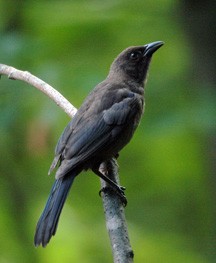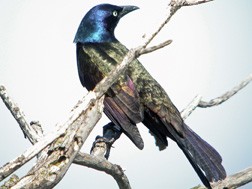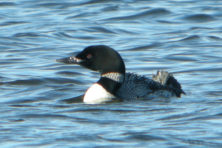The Not So Common Grackle
- Share
- Tweet
- Pin
- Share
Name a handsome bird about a foot long that has glossy shades of bronze, violet, green and purple on its head and upper body. If you were to add that this conspicuous, noisy creature displays a dignified swaggering walk and is often seen around small ponds and mud puddles in spring, surely you would recognize this bold bird as the Common Grackle, or simply Grackle as we call it.
During past years this bird was usually referred to as the Purple, Florida or Bronzed Grackle. Today they have been lumped together and given the unfortunate name of Common Grackle.

A hundred or more Grackles and Red-winged Blackbirds feed on cracked corn in the Lukes’ front yard on April 12, 2007.
A different species of Grackle, and new for us, that we saw at close range during our first trip one winter to Florida during the mid-1970s was the Boat-tailed Grackle, or possibly the Florida Boat-tailed species. That huge bird, sporting a long V-shaped tail, landed on our picnic table where we ate our lunch at a tourist wayside rest stop. Talk about a bold, cocky bird that virtually demanded some food handouts – which naturally we shared with it in order to have that born-scavenger pompously strutting within inches of where we sat. It was a very exciting and even somewhat intimidating new species to add to our life lists.
Like the American Robins, Starlings, waterfowl and Red-winged Blackbirds, the Grackles migrate during daylight hours in the footsteps of spring. They remind me of adventurous (sometimes misbehaving) little children who enjoy mud puddles, small rivulets, and just getting as close to the water, or into the shallow parts, without getting too wet. In this respect I would have been a typical Grackle, too.
Quiscalus quiscula (QWIS-ca-lus QWIS-cue-la – Latin name for Grackle, meaning who and of what kind) sounds a little bit like some of the “songs” (noise?) of the Grackles. The word Grackle itself rings somewhat of this glossy bird’s vocal efforts. One person interpreted some of its calls as sounding like “kogubaleek” and “koochokaweekee.” Some of these choruses sound like the opening and closing of a very old rusty hinge.
They are migratory in our region. I was able to photograph a hundred or more of them, mixed in with Red-winged Blackbirds, in front of our house and along the driveway on both April 6 and 12, 2007, with at least a foot of snow remaining on the ground nearby. (I grin when I suggest that you look at your calendar as you read this, to learn of today’s date!) I had been scattering small amounts of cracked corn along the edge of our front yard feeding area and also toward the end of the driveway nearest to our house, and this, in addition to the wonderful puddles of water from the melting snow, served as the prime attractors.

A young Grackle of the year, sex unknown, has a dark eye.
Their wedge-shaped tails, formed into a neat keel during flight, are quite distinctive and help one to easily separate them from, for example, Red-winged and Rusty Blackbirds and Starlings.
Iridescent hues on their feathers (more bronze on the backs of males), along with glaring pale yellowish irises, help to make this a very striking and easily identified creature in the sunlight as they nervously cock their tails up and down. To observe them lifting their shoulders, spreading the wings and tail and swelling up of their entire plumage further exaggerates their gorgeous colors on sunny days. The young birds tend to be browner and lack the iridescence.
Mention these audacious, but handsome black marauders to some people and you’re in for an argument. Unprintable words might flow from the mouths of some of these folks. Perhaps it’s the Grackles’ racket, call it their “squeaky wheelbarrow chorus,” that raises the dander of some people. The undignified label of nest robbers has been associated with Grackles for years and hasn’t improved their image one bit.
In the case that you may be “getting ideas,” the only unprotected songbirds in Wisconsin are the European Starlings, House Sparrows and Feral Rock Pigeons. You must have a valid small game license, along with permission from the DNR, to do away with Grackles. In some cases, a verbal authorization from your local conservation officer is sufficient.

This mature brightly colored male Grackle shows its iridescent bronze back.
If you were to examine the food habits of these resourceful foragers you would clearly see both a credit and debit side. Grubs, weed seeds and especially harmful insects including the Japanese Beetles and grasshoppers are included in their diets. In fact their young are fed mostly insects. Agriculturists point an accusing finger at these birds when they inspect damage, especially in their corn and wheat fields. However, research has shown that the maximum amount of corn is consumed during February and this amounts to waste corn lying on the ground in areas that receive little snow.
Very hard acorns, which they relish, don’t pose a problem to these birds. Inside and to the rear of the upper mandible is a raised, hard, narrow, somewhat saw-toothed keel, which the Grackles and other blackbird species use to cut into the thinner end and then forcefully crack the hard shell apart.

A mixture of adult Grackles and Red-winged Blackbirds feed together on April 6, 2007.
It was in the later 1960s that I observed some unusual bird-feeding activity over the water near the shore at Baileys Harbor. As had happened for several consecutive summers, there was a heavy build-up of Alewives in Lake Michigan, many of which ended up dead and floating on the surface of the water. Common and Caspian Terns were busy plucking them off the water and consuming them. Suddenly from some shrubbery flew a Grackle out over the water and, like the Terns, also plucked Alewives off the water to consume. Not to be outdone, a male Cardinal later did the same! My guess was that the Grackles learned about obtaining the excellent food source from the Terns and the Cardinal in turn learned from the Grackle. What good models of sustainability and adaptability these Grackles are.
If you have evergreen trees such as spruces on your property you stand a good chance of having them nest there, although they do prefer to nest fairly high, 30 feet or more, above the ground. Not only one pair but several are a possibility. Grackles are quite gregarious and communal in their nesting habits. These birds’ wide tolerance for nesting sites and food reflects their high degree of adaptability.
By the way, the oldest Grackle recorded lived to be 22 years, 11 months. What a durable bird!
A hundred or more years ago their numbers were generally confined to the eastern states. Slowly they extended their range westward following the expansion of agriculture. Even though their numbers have decreased slightly over the past several decades, undoubtedly their population is nevertheless going to remain very high. How glorious the day will be when all people become a part of Nature instead of masters over Nature, and can live with Grackles just as easily as with Black-capped Chickadees!

